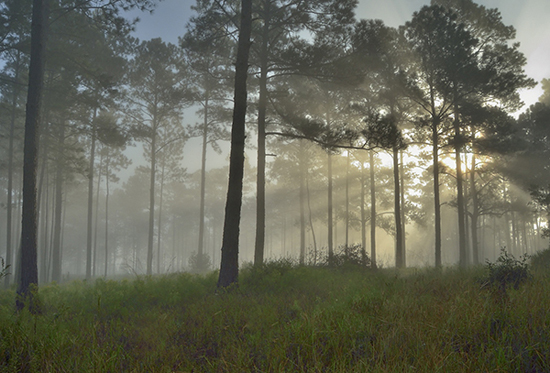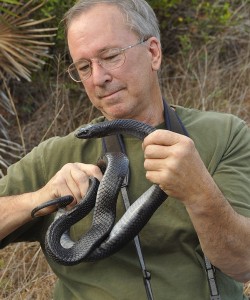
Sandhill Symphony, A Natural History of High Pine
In this 2015/2016 exhibit, more than 300 images, taken by Stetson University Professor Peter May (Biology), introduced visitors to the flora and fauna of this vanishing ecosystem. We asked Dr. May some questions about the inspiration for his photography and the hows of getting that perfect shot.
About The Photographer

Peter May is a Professor of Biology at Stetson University. Originally from Manassas, Virginia, he has lived in Florida since 1979 and in DeLand since 1988. He earned the BS and MS in Biology from George Mason University and the PhD in Zoology from the University of Florida.
In addition to being a published photographer, Prof. May publishes on ecology and the behavior of reptiles. He also posts wildlife photography to his blog Volusia Naturalist, along with significant sightings, field reports, and other bits of Florida natural history.
How do you "find" your shots?
I spend a lot of time cruising around looking for cool stuff. Cool stuff is a broad category for me; I'm interested in all aspects of the natural world, so finding subjects isn't usually a problem. Early mornings are important. I probably take 75% of my pictures in the first two hours after sunrise. Bird activity is highest then, and the light is warm, saturated and not too contrasty. There's no simple set of rules as to what shots attract me. It usually starts with an interesting subject.
What kinds of cameras and lenses do you use? Prefer?
I prefer what I use. I use Nikon bodies (D7100 and D7000 currently) and rely a lot on telephoto lenses for subjects that are difficult for me to approach for one reason or another. My workhorse lenses these days are a Sigma 150mm macro for insects and flowers, a 150-600mm Sigma for birds, mammals, larger herbs and big insects, and a 400mm Sigma for odonates and orthopterans. For landscapes and habitats, I use a 10-24mm Nikon.
How did you choose the images for this exhibit?
The first criterion, obviously, was that they had to be directly related to sandhill habitats. Beyond that, I like shots that are rich in detail and color. If they illustrate some key aspect of the ecology or behavior of an organism, so much the better.
Why did you include "High Pine" in the exhibit title?
I like the sound of it. It's more descriptive from a landscape perspective than the term sandhills, many examples of which are lacking in any noticeable hills. All are found at higher elevations (such as they are), though, on relict dunes and ridges, and are dominated by pines (and grasses), at least in a mature state. Probably most importantly, the great Florida naturalist Archie Carr used that term.
Sandhill Symphony, a Natural History of High Pine was on display in the Gillespie Museum from September 26, 2015, to May 4, 2016.
Pollinator Photography
The album below features some of Dr. May's photos of native pollinators (also currently displayed on a looping monitor in the museum in association with the Volusia Sandhill Pollinator Project, a collaborative research project with Dr. Cindy Bennington, Stetson, Biology, to measure pollinator visitation rate and species composition in the campus longleaf pine restoration site). These photos were taken in the Volusia Sandhill Ecosystem teaching landscape adjacent to the museum and at other locations around DeLand.
